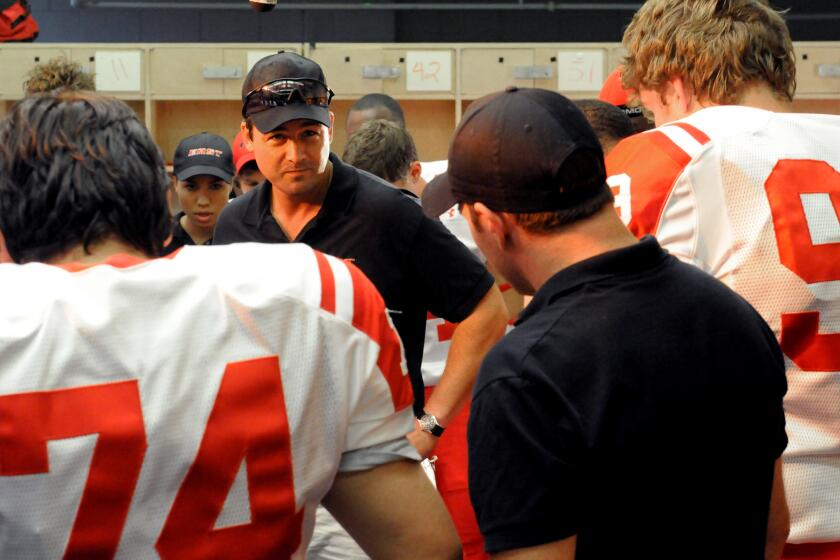Time for a Refresher Course in Media Literacy
Before taking over “The Tonight Show,” Johnny Carson hosted a daytime program called “Who Do You Trust?”--a timely question for both those in and outside the media to ponder in the context of what to believe as images spill out of the TV.
Despite the familiar adage that a picture is worth a thousand words, the truth is what sights producers choose to show us, and the way they’re presented, dramatically affect how we perceive them.
And while television’s standing as a primary news source, thanks to its immediacy and ability to beam images across the world, is undeniable, the medium often doesn’t do a lot to engender trust--a shortcoming that becomes more significant when news outlets must deal with wartime issues, as opposed to, say, the details of Jennifer Lopez’s wedding.
Television plays such a pivotal role in the national debate, in fact, that it seems a good time to again raise the issue of media literacy--a movement aimed primarily at children, though adults can clearly benefit from its precepts as well.
In a nutshell, media literacy focuses on providing the tools necessary to help viewers be more analytical in the way they evaluate and deconstruct media, from understanding its “language”--how images are assembled through the use of editing, sound or music, among other tricks used to hook an audience--to the influence of the profit imperative.
As Tessa Jolls, president of the Santa Monica-based Center for Media Literacy, put it, “Media are our most powerful teachers, and if we accept that they are going to be our most powerful teachers, then how do we deal with it in a democratic society?”
Discussions of media literacy often focus on news--how seeing Arab crowds celebrating tragedy in the U.S., for example, conveys a message that goes far beyond the pictures themselves. Just as important, however, is the way the entertainment programs that bracket news help undermine the medium’s credibility--folding, spindling and mutilating reality to craft compelling stories and keep the profit machine churning.
The last six months have yielded a string of incidents and allegations reminding us that truth is not only a frequent casualty of war but also the headlong rush to attract ratings. For starters, “Survivor” contestant Dirk Been gave deposition testimony at least in part supporting fellow player Stacey Stillman’s lawsuit contending that producer Mark Burnett sought to manipulate the voting and thus the outcome of the game. Burnett denied the charges but has admitted using body doubles to reenact scenes in his so-called reality series.
Later in the summer, journalist Peter Lance revealed on his Web site https://thestingray.net that the UPN series “Manhunt” re-shot sequences in Griffith Park long after the original action took place in Hawaii. Earlier this month, two contestants on the daytime series “Talk or Walk” went public with charges the program’s producer, Scott Sternberg, stopped taping of the relationship show and told one of them, Carlisa Hamagaki, to choose “walk”--that is, end the relationship with friend David Lerman--to make the episode more satisfying to viewers. Lerman claims to have suffered a nervous breakdown after the experience.
For her part, Hamagaki said she assumed a degree of play acting must be part of the routine. “I’m not a seasoned talk-show person,” she said, adding, “I saw the show as something not real.”
Sternberg and Tribune Entertainment, which distributes “Talk or Walk,” declined comment. Granted, the show is averaging a puny 0.7 rating nationally--meaning 99.3% of U.S. homes are avoiding the series on a daily basis--so its transgressions, at least, will probably be short-lived. (Speaking of media literacy, it’s worth knowing news organizations sometimes have awkward corporate ties, and that the show’s distributor and the Los Angeles Times are both owned by Tribune Co.)
Finally, Studios USA acknowledged plans last week to tape episodes of “Crossing Over With John Edward” in which the psychic medium would attempt to communicate with those killed at the World Trade Center on behalf of bereaved relatives.
That the episodes in question would have been broadcast during the November rating sweeps was couched as a happy coincidence, before negative reaction prompted executives to quickly backpedal, apparently realizing that exploiting a tragedy of this magnitude (they certainly have no compunctions about exploiting people on a smaller scale) was ill-advised at best and tasteless at worst.
Unfortunately, tinkering with shows to make them more compelling--as allegedly occurred on “Talk or Walk” and several other unscripted series--is hardly uncommon, one reason plenty of viewers tacitly accept that much of what they see on television is “something not real.”
The problem, of course, is that these programs play on TV stations that do expect to be taken seriously at other times in the day--stations that send mixed signals even within their newscasts, making the somewhat jarring transition from KABC-TV anchor Marc Brown to “entertainment guru” George Pennacchio, or from reporting on Afghanistan to shilling for “Survivor.”
Thanks to new technology, viewers can’t even believe their eyes. As a case in point, consider Fox’s World Series telecasts, which superimpose behind the batter rotating billboard-sized ads for the network’s series--” ’Ally McBeal’ Is Back Tomorrow!”--that aren’t visible within the stadium. Fox dubs the practice “virtual signage,” reflecting a sort of “Wag the Dog” mentality relying on the fact the public has been so bludgeoned into submission by TV’s self-promotional excesses that such manipulations will go largely ignored.
Given the bombardment of such indiscretions, organizations like the Center for Media Literacy have an increasingly valuable role to play in teaching viewers to be discerning without giving in completely to cynicism, which can be equally damaging.
“We don’t want people to be cynical,” Jolls said. “We need to give people the tools to be skeptical viewers.”
As reasonable as that sounds, few media companies have warmed to the notion of funding such programs. According to Jolls, many remain leery of the concept, failing to grasp that the nonprofit group is not advocating censorship but “empowerment through education”--a mission laudably reflected by the recent Court TV documentary “Mind Over Media,” a primer on media literacy representing one of those too rare instances when television uses its bully pulpit to examine itself.
If nothing else, one would think self-interest--the value of generating trust--should motivate TV outlets to support such efforts. Perhaps if some of these companies weren’t so busy creating “virtual” realities or trying to contact the dead for fun and profit, they might find the time and resources to help educate the living.
*
Brian Lowry’s column appears Wednesdays. He can be reached via email at brian.lowry@latimes.com.
The complete guide to home viewing
Get Screen Gab for everything about the TV shows and streaming movies everyone’s talking about.
You may occasionally receive promotional content from the Los Angeles Times.



